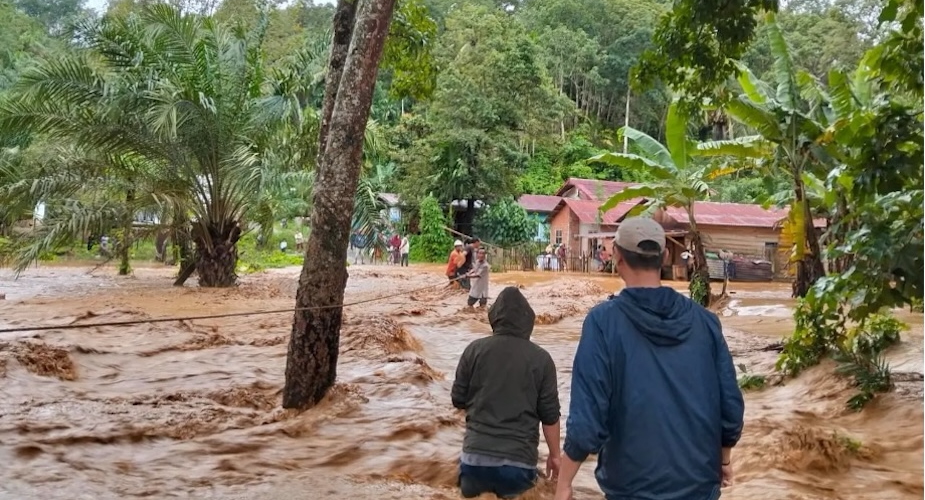TOM PLUMMER talks with a graphic artist in Yogyakarta whose work is drawing international praise.
Agung Kurniawan appears unfazed by his prize at the Philip Morris 1996 ASEAN Art Awards, held in Bangkok between 16 August and 1 September. Considering the Awards attracted over 3000 entrants from seven ASEAN countries, fifth prize is quite an achievement. We spent an afternoon together in his studio in Yogyakarta. Agung elaborated on meaning, symbols and creative process and showed me some of his newest work.
I first came across Agung at an exhibition in the Cemeti contemporary art gallery, in the grounds of the sultan's palace in Yogyakarta, in 1994. Then I saw the illustrations he did for Seno Gumira Ajidarma's 1994 book of short stories on East Timor,Saksi Mata. (Unfortunately these did not appear in the English translation, Eyewitness.)
Anonymity
The mood portrayed by the Saksi Mata illustrations blends well with images created by the text - pain, torture, helplessness, victimisation. Their most distinctive feature is the anonymity of the figures - heads cut off above the mouth, faces masked and gagged, or clown-like. Anonymity is a shared characteristic that makes the pairing of Seno's words and Agung's drawings extremely appropriate.
Nothing is mentioned explicitly by illustrator or writer. Identities are never clearly delineated, only a strong suggestion that pain and torture are common phenomena in the society from which the artist and writer draw their inspiration.
Agung declares: 'My main theme is violence'. Stories of torture and intimidation emerging from the military crackdown after the July 27 riots make us realise that violence, both physical and mental, strongly informs New Order power relations.
Nails
'Happy Victims' (Korban yang Bergembira) is the title of a series of ten charcoal works that won him the ASEAN Art Award. In each piece an almost lifesize figure hangs upside down in what appears to be a well. Figures are bound, gagged, masked, strait-jacketed, and nails pierce the skin. Those whose faces are visible seem to smile through red clown mouths. Apart from these bands of red which form the mouths, and occasional smudges of yellow, it is black that reigns.
The well derives from the Lubang Buaya (Crocodile Hole), into which six murdered generals and a lieutenant were thrown on the night of 30 September 1965, to begin the infamous coup. The atmosphere of cruelty and terror is difficult to miss. Imagine the horror of being bound and hung upside down in a well. 'I wanted to show how people can live in the midst of a violence and repression so pervasive and enduring that they have become unaware', explains Agung.
Their smiles are those of clowns, they are not real smiles. Nails jabbing into the skin of the happy victims consolidate the idea of living whilst being subtly tortured.
Clown
In another work, 'The Great Holy Family Number One', stand four figures who are obviously not the typical Javanese family. Father is dressed in a military uniform, possibly that of a general. Mother stands with a handbag hanging from her wrist and a shawl draped across her shoulder. Their daughter is also present. Her muscled arms are crossed, and she smiles stupidly through the familiar red mouth of a clown.
In the middle stands the large, sturdy figure of a henchman - balaclava, pistol in a holster at his shoulder and two daggers, one bloodstained, protruding from his belt. Identity remains implicit, yet is clearer here than for the ten Happy Victims. And maybe this is the intention of the artist.
Agung manages to make a reasonable living from his art. It has appeared at a diverse number of sites including the cosmopolitan Jakarta-based journal of contemporary art Kalam, in the collections of Indonesian art enthusiasts, and internationally in the Queensland Art Gallery. His success is significant considering his age, 28, and the fact that financial support for Indonesian artists is virtually non-existent.
Weird
Over the course of the afternoon we looked at and chatted about dozens of Agung's pieces. One is left with no doubt as to the high level of his creative productivity. The appearance of larger works was punctuated by smaller, equally impressive palm- sized pieces - weird images of twisted cows, pigs and prophets, most of which will never be seen beyond the studio door. These, he says, are what he produces when the mind becomes jammed whilst working on larger pieces.
Each piece, however big or small, becomes part of a series that constitutes the web of violence that both inspires and restricts what becomes manifest in contemporary art practice in Indonesia.
Tom Plummer is doing Indonesian Studies at Murdoch University.











